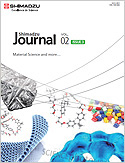Vol.2, Issue3-September 2014 CONTENT
Focused on Material Science
 |
Shimadzu Journal Vol.2, Issue3-September 2014 (1,796 KB) Material Science |
 |
[Insight from a customer] Professor Frank Walther of TU Dortmund University (Page 82-84) We interviewed Professor Dr. Frank Walther, Head of the Department of Materials Test Engineering (WPT) at TU Dortmund University in Germany. His research is focused on microstructure-based materials and components testing, destructive and non-destructive testing and measurement techniques as applied to characterizing structure-property relationships, evaluating the fatigue performance, failure mechanisms and damage processes, and predicting remaining fatigue life.
|
 |
[New Material] Influence of Deformation Speed and Humidity on Quasistatic Deformation Behavior of Vulcanized Fiber – Experiments with Different Load and Climate Profiles. (Page 85-87) Detailed knowledge of a material's properties is a basic requirement for design and production engineers in order to ensure safe and efficient operation conditions of structural components. This article presents an investigation and evaluation of the insufficiently studied construction material, vulcanized fiber, regarding the influence of deformation speed and relative humidity on its quasistatic properties.
|
 |
[New Technology]
In recent years, there has been a rapid increase in the applications for carbon fiber reinforced plastics and other composite materials for commercial passenger aircraft. Even today, as much as half of the weight of some aircraft being used consists of composite materials. When building aircraft, in addition to strict safety requirements, there is a need for lightness. For these reasons, there is not much leeway when it comes to safety as compared with other structures.
|
 |
Shimadzu Selection (Page 90-91)
Shimadzu selected the following articles for this issue. They derive from application notes related to material sciences, and utilize a variety of instruments we produce. Cutting-edge technologies are also included. Please obtain the articles of your interest through the links on the titles.
|
 |
[Polymer]
Analysis of Minor Components in Synthetic Polymers Using SEC-AccuSpot-AXIMA System (Page 92-93) MALDI-TOF mass spectrometry is widely used as a technique for the characterization of synthetic polymers. However, when multiple components are present in samples, major components may suppress ionization of the trace components present, preventing their detection.
|
 |
[Topics]
Shimadzu Lab Network (Page 94-95) Learn about Shimadzu's global network of customer support and application development centers. |
 |
[Topics]
Shimadzu (Asia Pacific) signs MoU with NERI, sets up NUS-Shimadzu Advanced Facility for Ecoanalytics (NUSAFE) (Page 96-97)
Singapore-based Shimadzu (Asia Pacific) and the National University of Singapore Environmental Research Institute (NERI) have signed a Memorandum of Understanding (MoU) to establish a joint facility to conduct environmental analytical research. The facility will be called NUS-Shimadzu Advanced Facility for Ecoanalytics or NUSAFE.
|
 |
[Topics]
The Royal Society of Chemistry has selected our paper, Noriko Iwamoto et al., Life Science Research Center, Shimadzu Corporation, as one of its Hot Articles. This report results from a collaboration with the National Cancer Center in Japan.
|
 |
[Product Information] |



